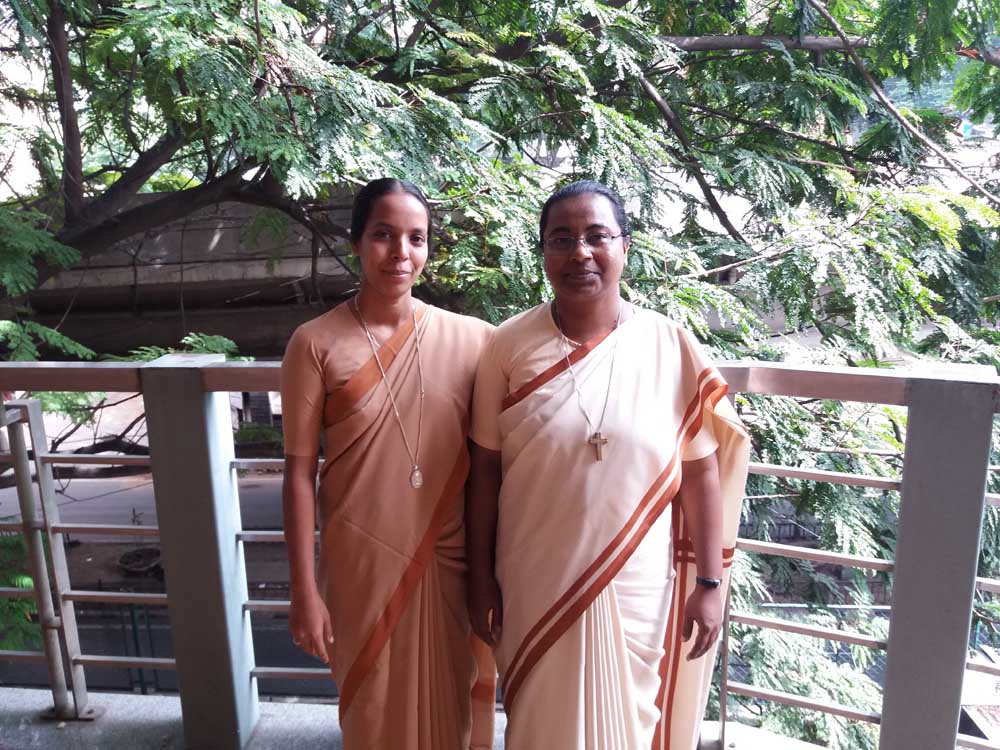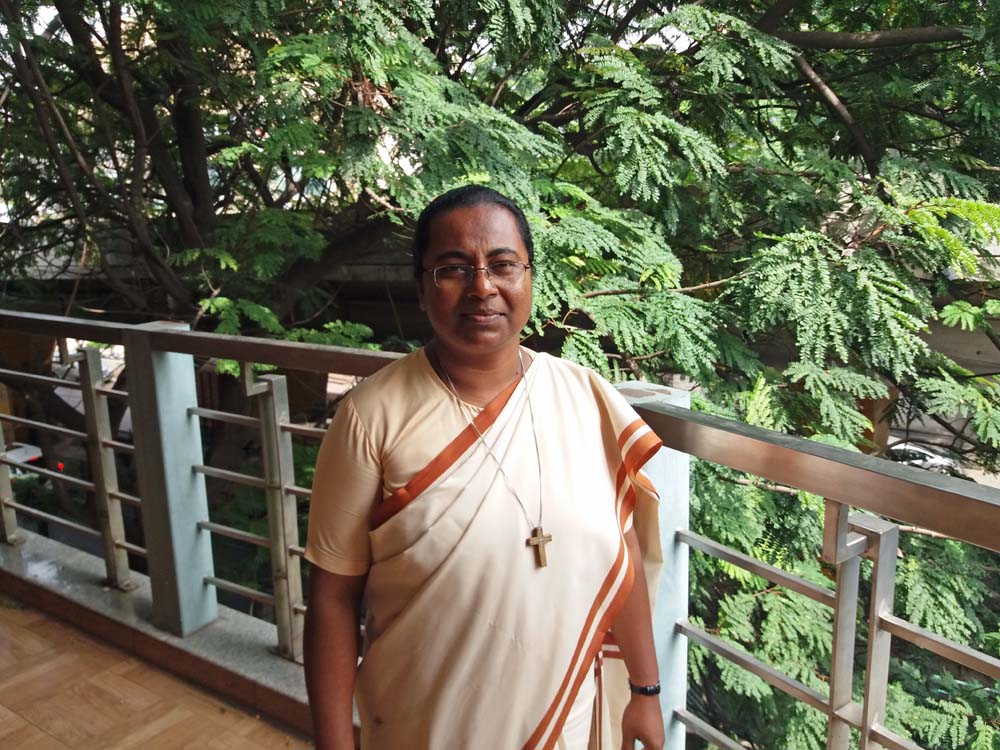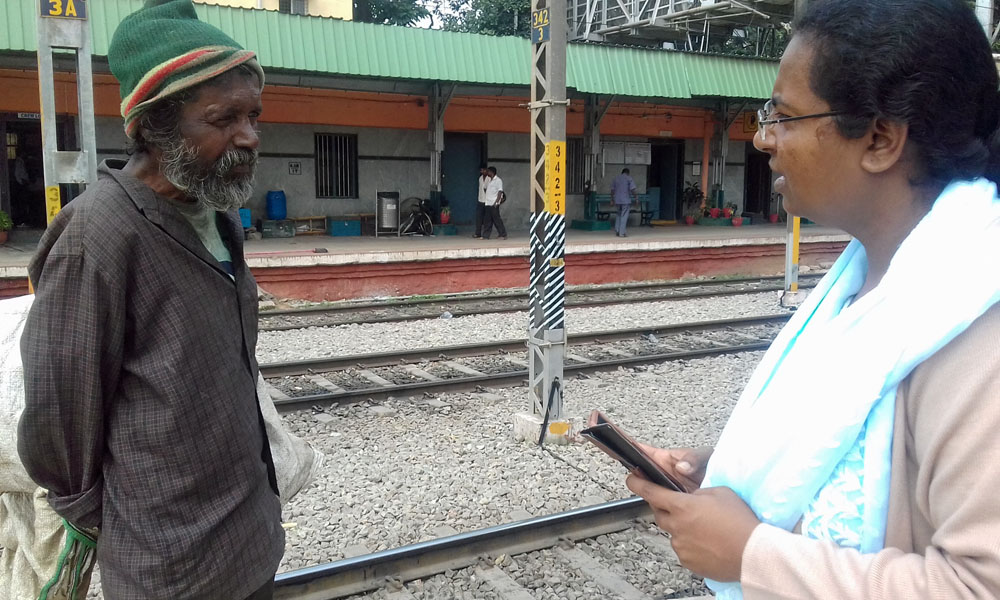
Bengaluru, India — Sr. Ancila Devadass and Sr. Mary Nijo belong to two different congregations, but that does not hinder them from working together for Color the Fallen Stars, a project helping people who live in poverty in Bengaluru, a southern Indian city.
Devadass, 37, a member of the Daughters of the Church, is the director of the project, and Nijo, 29, of the Canossian Daughters of Charity supports her as the project manager. They work full time with the project.
The two nuns shared their work and experiences with GSR.
GSR: What is the Color the Fallen Stars?
Devadass: It is a project launched in 2016 in Bengaluru to help destitute people found on the city streets. It was the outcome of a meeting of representatives of various religious congregations, NGOs and likeminded people in Bengaluru who were concerned about the elderly people abandoned in Indian cities, especially in Bengaluru. The Dream India Network [an initiative of professional social workers] had convened the meeting. The meeting called the destitute "fallen stars who wait for someone to color their dreams."
Please elaborate on your work.
Devadass: We try to make the destitute people feel respected and dignified. All of us are stars. The people with whom we work are the stars that are fallen. They need help to find meaning in their lives.
We do not wait for stars to fall from the sky to color them. Instead, we go to the streets looking for them. On any given day, we can find at least 30,000 people abandoned and homeless on the streets of Bengaluru. They have no access to food, clothing and shelter. Some suffer from physical and mental problems that go undiagnosed and untreated.
We ensure these people are not sidelined or ignored just because they have nobody to help them.
Nijo: Color the Fallen Stars is committed to supporting the most disadvantaged elders left to fend for themselves on the streets. We try to rescue them, especially those on the verge of death. With their consent and with the help of the local police, we take them to rehabilitation centers in Bengaluru.
How many fallen stars have you colored so far?
We have rescued 25 destitute people from June 1, 2017, to June 10, 2018.

That is small compared to the number of people on the streets. Why?
Nijo: The number might look minuscule, but we function under limitations, such as funds, personnel and so on. Until June this year, we did not have a vehicle or ambulance to take the people to the rescue homes. Many destitute don't want to go to a rescue home, fearing for their freedom. Sometimes it takes weeks and months to convince one person to go to a home.
Where are the rescued now?
Devadass: They are placed in various rehabilitation centers run by NGOs in Bengaluru. Many are accommodated at RVM Foundation Humanitarian Hospital and Transit Home in the city. [Ravi V. Melwani, a Bengaluru-based Indian philanthropist, started the centers in 1998 to provide long-term care to the underprivileged, homeless children, elderly, abandoned women, and those who are physically and mentally challenged.]
Tell us about the rehabilitation work.
Nijo: We visit them in rehabilitation centers at least once a month. We make sure the destitute get proper care and attention in those centers. The centers give them baths and food. We ensure they get timely food and clothing and, if needed, medical care. We also arrange professional counseling for those in need.
When the destitute get well, the rehabilitation centers consult with Dream India Network to plan the future course of action for them.

How many did get well in the past year? What are they doing now?
Nijo: Some 20 of those who underwent medical treatment are doing well now. They are enjoying life under the care and protection of the rehabilitation center.
What is your day like when you look for destitute people?
Devadass: We just walk on the streets, and when we see someone in shabby clothes lying on the roadside, we go closer and try to talk to them. We ask about their backgrounds, and if they need help immediately, we inform the local police. Later, with their consent, we take them to a rehabilitation center.

Does the public support you?
Nijo: Yes, the public helps us carry the destitute to the ambulance. If they know the destitute, they share with us the person's details.
Have you faced any opposition from the public?
Devadass: Yes, in the beginning. But now people know what we are doing, and they are helpful and supportive.
Nijo: We inform the nearest police station about what we do. So we face few problems now.
So, you have no challenges now?
Devadass: Life is full of challenges. In this modern world, to live a Christian life — and, moreover, a religious life — is a challenge. I am happy to be a part of that challenge for the sake of Christ and for his people. But I feel society does not accept the service we render for people. This may be because of the wrong notion that whatever we, the Catholic religious, do has an ulterior motive: to convert people to Christianity.

Nijo: One of the challenges for me is to have sufficient funds to run the project.
Do your congregations support you?
Devadass: Not financially. However, my congregation has allowed me to work full time on this project. It has not given me any work in the congregation. If I need any help, the congregation always obliges.
Nijo: The sisters in my community accept, encourage and trust me. They give me full support in my work.
You come from two different congregations. How do you work as a team?
Devadass: Sr. Mary Nijo and I do all that is needed to take the project forward. When we are in doubt or when we need help, we go to our senior colleagues for advice and guidance. Both of us sisters work as a team.
One beautiful thing about our work is that although we belong to two different congregations, we could work as a team. We don't see any problem in working cooperatively with understanding and mutual respect for a cause.
Nijo: I find it is a strength that we are from different congregations. We bring our special charism into the work. This teamwork has also given me an opportunity to learn about another congregation.

What made you become a sister?
Devadass: I noticed as a teenager that the sisters led a very different lifestyle from people in the family and society. That attracted me.
Nijo: I was involved in church activities when I was young. I didn't have any systematic plans to become a religious. I think I have strayed into it, if I may say so. Today, I feel so happy that I'm a bride of Jesus.
What is your inspiration to work for the poor and the marginalized?
Devadass: It's purely my love for Jesus. He makes me feel for those in need. With my little ability and by the grace of God, I render my service for their welfare. I believe in God, who has always been very generous in his love and mercy to me.
Nijo: It is my love and concern for the poor. Not only those who are financially poor, but also those who are poor in spirit. I like to reach out to them. I want to be a voice for the voiceless in the society.
[Philip Mathew is a journalist based in Bangalore, southern India. He edits Asia Pacific Ecumenical News and writes for Matters India, a news portal that focuses on religious and social issues.]

